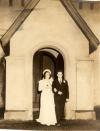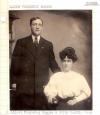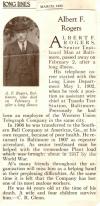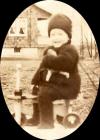Jean Patricia Rogers
Jean Patricia ( Pat ) Rogers was born October 2, 1922, to Albert Frederick Rogers,( 1881 - 1925 ) and his wife Edith Cecilia, nee Jean,( 1887 - 1947 ), who had married on March 28, 1906. Pat was the youngest of the four Rogers children, two sisters, Edith Georgia, ( 1907 - 1993 ) and Mary Louise ( 1908 - 1989 ), and one brother Robert Cummins, ( 1915 - 2003 ).
Albert F. Rogers was a Senior Testboard Man in the Long Lines Department at American Telephone & Telegraph in Baltimore. Pat was only three years old when her father died at age 44. In 1925 Social Security was still ten years in the future, so unless he had some life insurance, he left his family with no source of income and probably a mortgage on their Linthicum home that had been built for them in 1919. Edee was 18, Louise, who had been committed to a state mental facility because of a fall down the stairs, and / or complications of a medical operation, was 17. Bob was 10 years old. Edee was old enough to get a job to help support herself, but Bob and Pat were not. At some point during The Depression the family had to sell the house on Hilltop Road, and Mrs. Rogers got a job at Dunn & Bradstreet in Baltimore. Bob was sent to McDonogh School, which had been established as a military-style boarding school to educate orphan boys. When she was old enough, Pat went to Samuel Ready School which had been established to board and educate orphan girls.
Following graduation, Pat got a job at Aberdeen Proving Ground in Hartford County, MD. She was employed there until after the war ended when she met a young sailor named Wilton Forrest Garrett, whom everyone called Jerry. Jerry was nine months younger than Pat and had a super, easy-to-like personality. On March 2, 1946 Pat and Jerry were married in a little church in Perryman, MD.
They bought a 1920’s bungalow on Mountain Road in North Linthicum, and Bernie’s 1941 Plymouth sedan. Jerry attended one of the many technical schools that popped up following the war that were designed to train returning veterans with funds supplied by the GI Bill. There he studied radio repair and met Burt Kirby who lived nearby, in Linthicum. Together they set up a radio repair business in the basement of Pat and Jerry’s house. What the technical school had failed to mention, and Burt and Jerry didn’t realize, was that people who had been forced to have their 1920’s and 30’s radios repaired during the war were now able to buy brand-new radios. The radio repair and sales business ended with the basement floor filled with repaired old radios that they could not sell.
Jerry was very skilled in making items from sheet metal, so he began crafting exterior post lights from copper and making metal housings for exhaust fans. Again the market was limited and did not produce enough income. He was able to use his talents in a job at Bendix Radio in Towson.
On August 4, 1947 Glenn Forrest Garrett, the first of Pat and Jerry’s four sons was born. Dennis Robert, followed on November 24, 1949. Douglas Rogers on November 23, 1954, and Larry Scott on August 22, 1956.
On October 10, 1947, shortly after Glenn was born, Pat’s mother, Edith Rogers died. Mrs Rogers had been living with Pat and Jerry at the time.
As their family expanded and Jerry changed jobs they moved around the Baltimore area before settling in Tarpan Springs, Florida, in the mid 1950’s. There Pat got a job in the office of a public school, where she worked until retirement.
With all of the difficulties and challenges that Pat faced, starting in her childhood, she was always up beat and cheerful. Jean Patricia Garret died on December 7, 1998.

Vacation with Aunt Pat
Aunt Pat has always been very high on my ’Favorite Persons’ list, mainly because I always knew that she cared for me. One example of this occurred during World War II when she invited Peter and me to spend a week with her in Perryman, Md. She was working at the U.S. Government’s Aberdeen Proving Ground and living in a renter room in a large Victorian house in nearby Perryman. Aberdeen Proving Ground is a 113-square-mile facility located on the Chesapeake Bay, adjoining the Edgewood Arsenal. It was opened in 1917 to test and develop military equipment.
Because of the wartime gasoline rationing, we made the trip to see her by train. Edee took us on the Baltimore & Annapolis R.R. train to Camden Station,and bought us tickets to Aberdeen on the Baltimore & Ohio R.R.. She took us down the stair to the north-bound train platform. She saw that we got on the train safely, and probably asked the conductor to make sure we got off in Aberdeen; then we were on our own. As soon as the train started, we entered the darkness of the tunnel under Howard Street. When we emerged from the tunnel at Mount Royal Station the electric locomotive used in the tunnel was uncoupled and a steam locomotive was coupled on. It was a great ride and adventure on the trip to Aberdeen, which seemed longer than it actually was ( probably about 1/2 hour).
When we got off the train in Aberdeen, Aunt Pat met us; and we got into a car, owned by a friend of Pat’s, for the trip to her boarding house.
The Victorian house where we stayed was only a few hundred feet from the main line of the Pennsylvania Railroad, and every half-hour or so, a fast passenger train, pulled by a GG1 electric locomotive, would go speeding by. There would also be the slower and longer trains with freight cars bearing logos from railroads all over America. During our stay Pat took us up into the attic of the house where we could see all the cracks in the plaster caused by vibrations from these trains. ( In 1971 the PRR became Amtrack’s right-of-way between New York City and Washington, DC. and when I went to New York, I would look for that Victorian house, which stood beside the tracks until it was torn down during the 1980’s ).
Perryman had a small store with, I think, the little post office. It was just down the street that ran beside the train tracks from the house to the intersection with the main road. I would walk along this street while hoping a train would come zooming by.
Pat took us swimming in the nearby Bush River. The family she rented her room from, or friends of theirs, had a house overlooking the river. In the picture you will see Peter and me with Pat’s boyfriend at the road beside the river.
Behind the Victorian house were a number of chicken houses as this family was in the chicken and egg business. These building can be seen in the background in the photo of Pat with the owner’s dog. We explored these places and had a wonderful time with Pat who treated us to picnics and parties.
When it was time to return home to Linthicum, Pat’s boyfriend, who had a convertible and enough gas for the trip, let us sit in the back seat with the top down. What I remember most about our trip on the newly-opened Pulaski Highway was crossing over some overpasses that had the tops of young trees sticking up through the overpass openings.
When I think back on this trip, I realize that our aunt devoted a week of her vacation time to helping two young boys have a memorable vacation. I have other pleasant memories of Aunt Pat. Every time I open my 1947 Webster’s Collegiate Dictionary or my alligator-skin photo album, I remember that they were gifts from this very special person.

Samuel Ready School
In 1864 Samuel Ready, a prominent Baltimore businessman, donated money to establish a female orphan asylum, following his death. The Samuel Ready School at 1400 E. North Avenue and Harford Road, in Baltimore, opened in 1887. Samuel Ready was modeled along the lines of McDonogh School, but without the farm atmosphere and the military uniforms. Orphan girls were boarded on the upper floors above the classrooms. In addition to academic studies the girls were taught domestic skills including making their own school clothes.

Pat & Jerry’s wedding March 2, 1946
The wedding photographer captured this image of Mr. & Mrs. Wilton Forrest Garrett emerging from the church. I was eleven at the time, and this was the first wedding I attended. I must confess that the photographer was, to me, the most memorable part of the service. We were seated in the first row of the church. During the service the photographer came up the center aisle snapping photos. He then proceeded to climb over the front railing to get close-up shots. The minister stopped the service, turned toward the photographer, and told him that this was a sacred service; he must remove himself to the rear of the church and wait until the service was over before taking any more photographs.
Contact Page Admin
Contact Page Administrators
Send a message to the administrators of this page.
In order to share a story you must register for an account. If you have an account already, please login here. Otherwise, click here to create your account.
Click 'Ok' to stay logged in.






